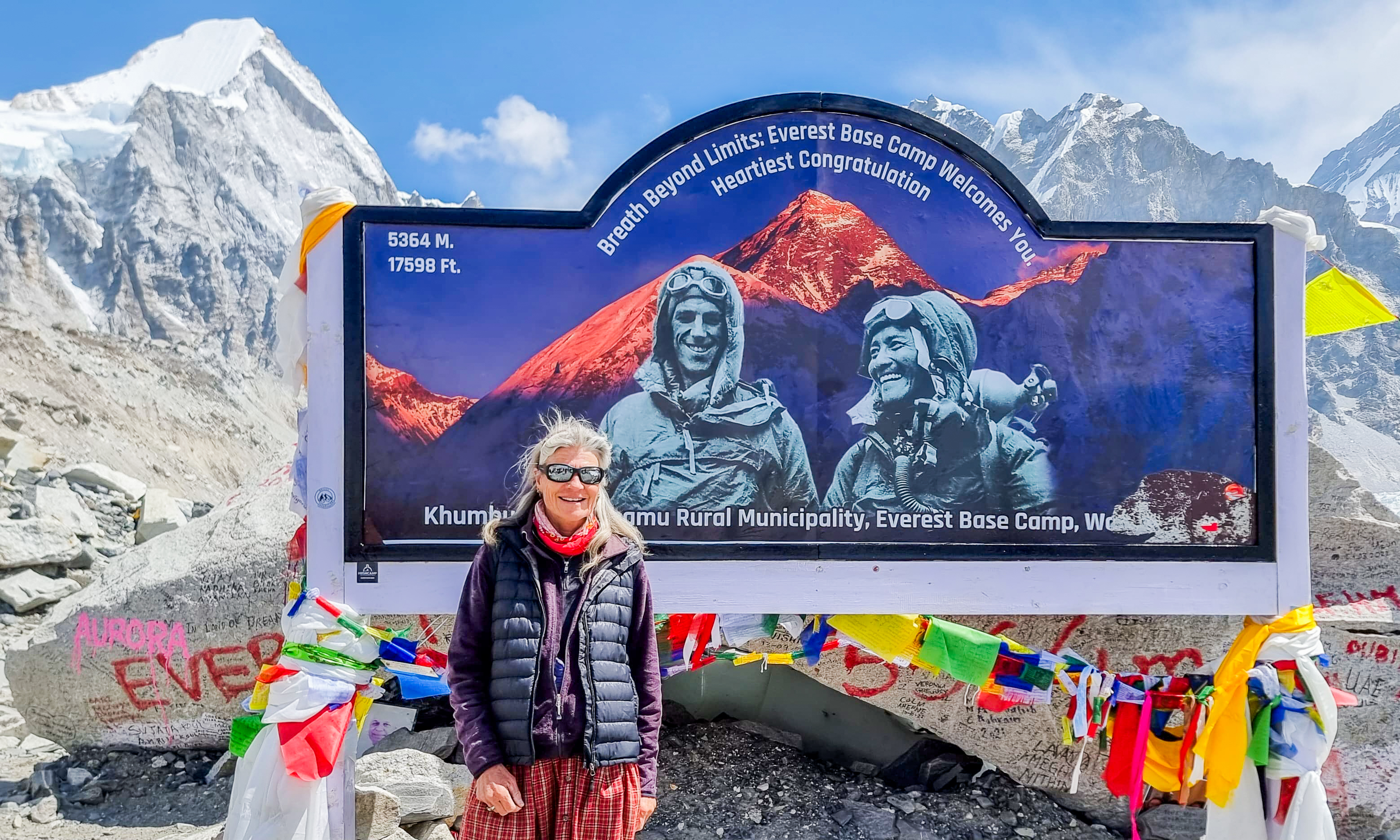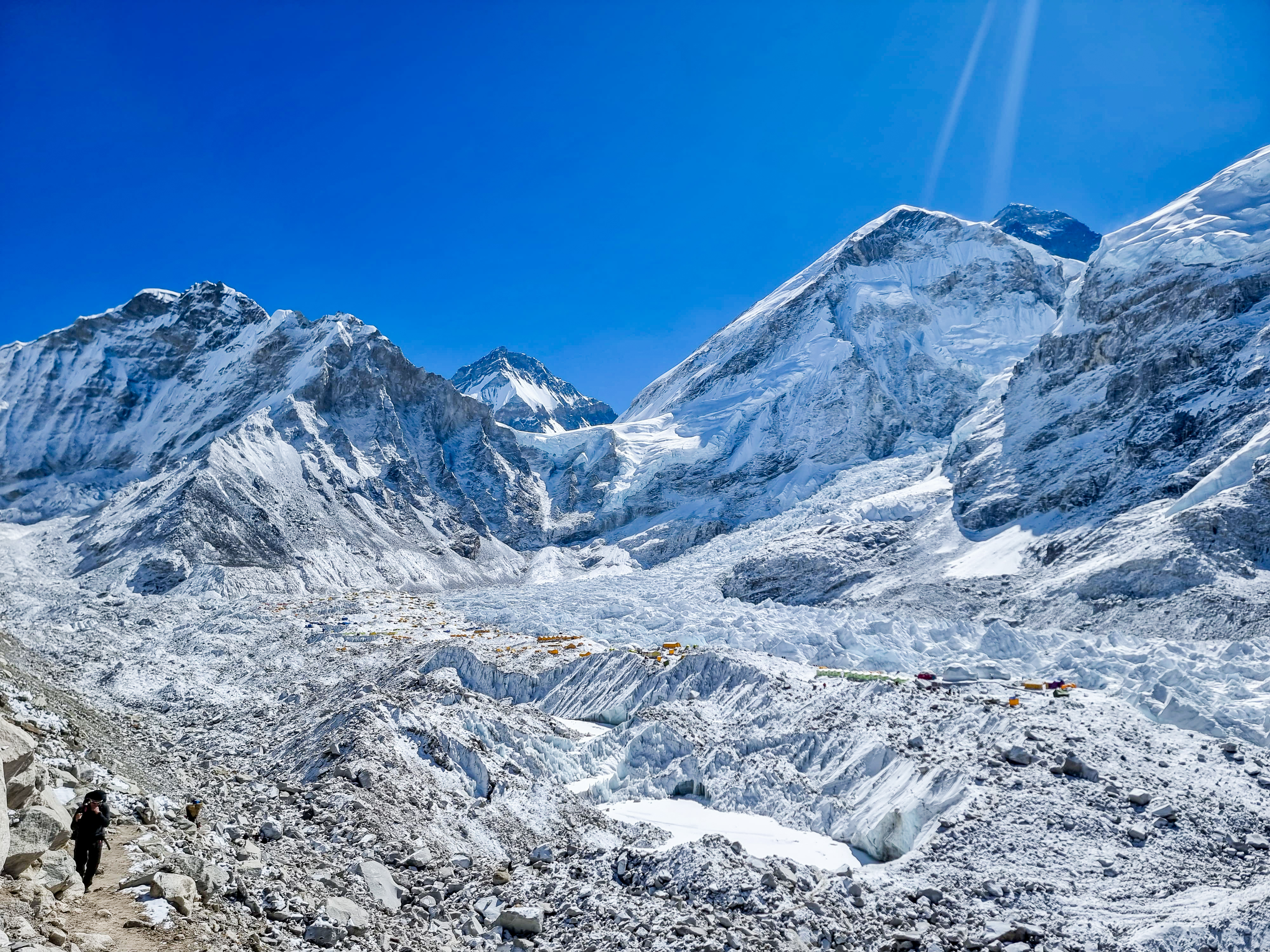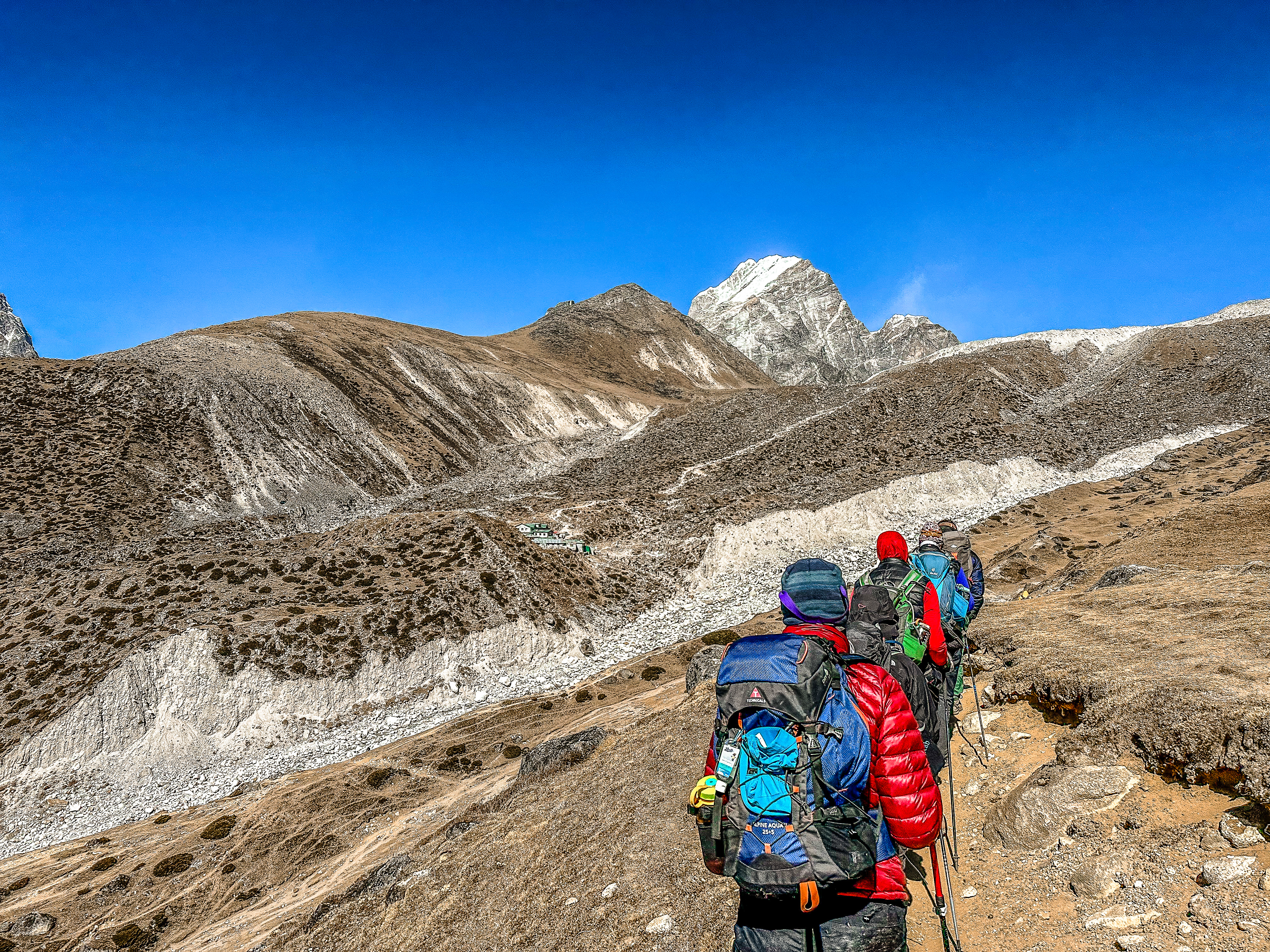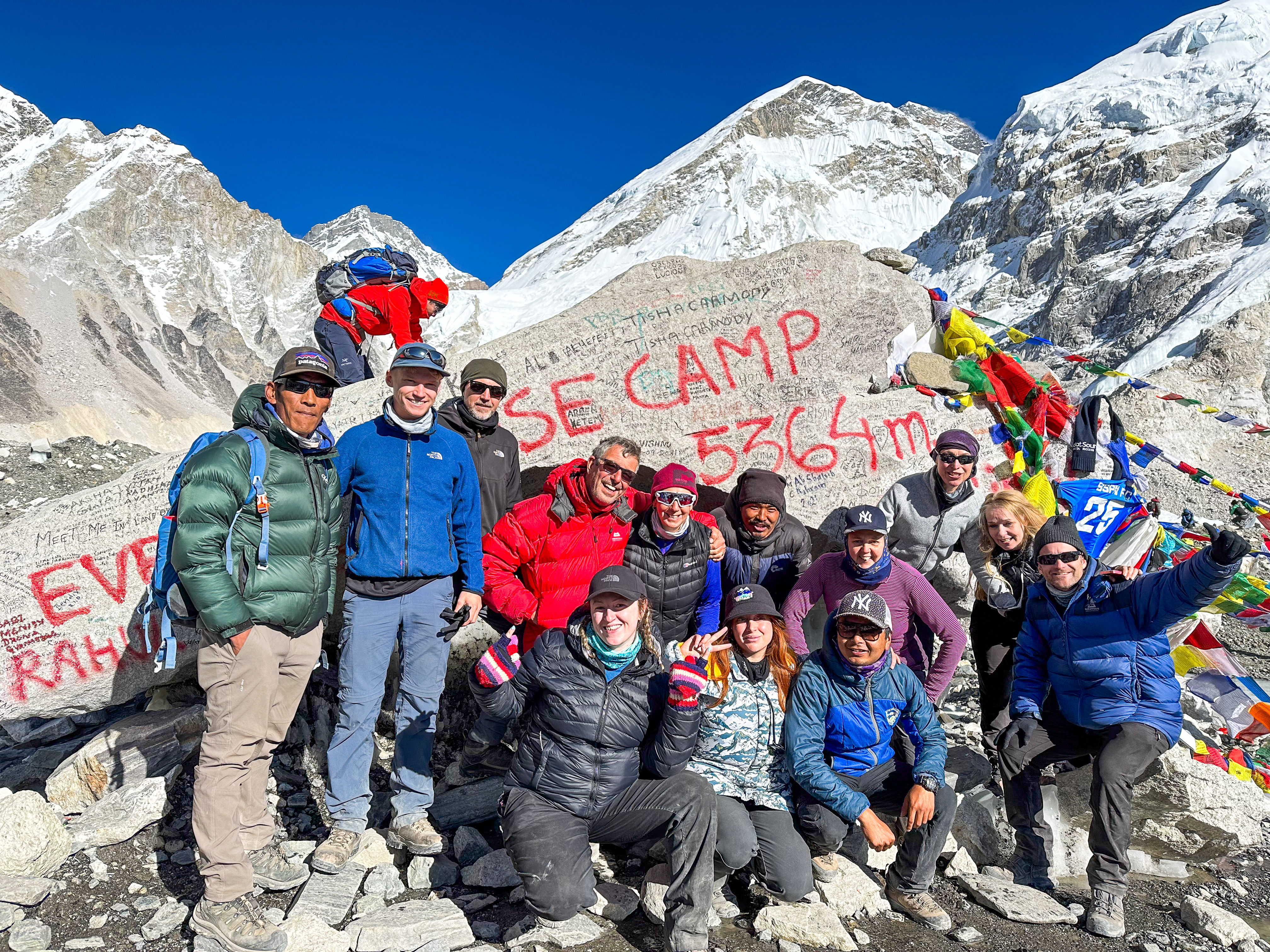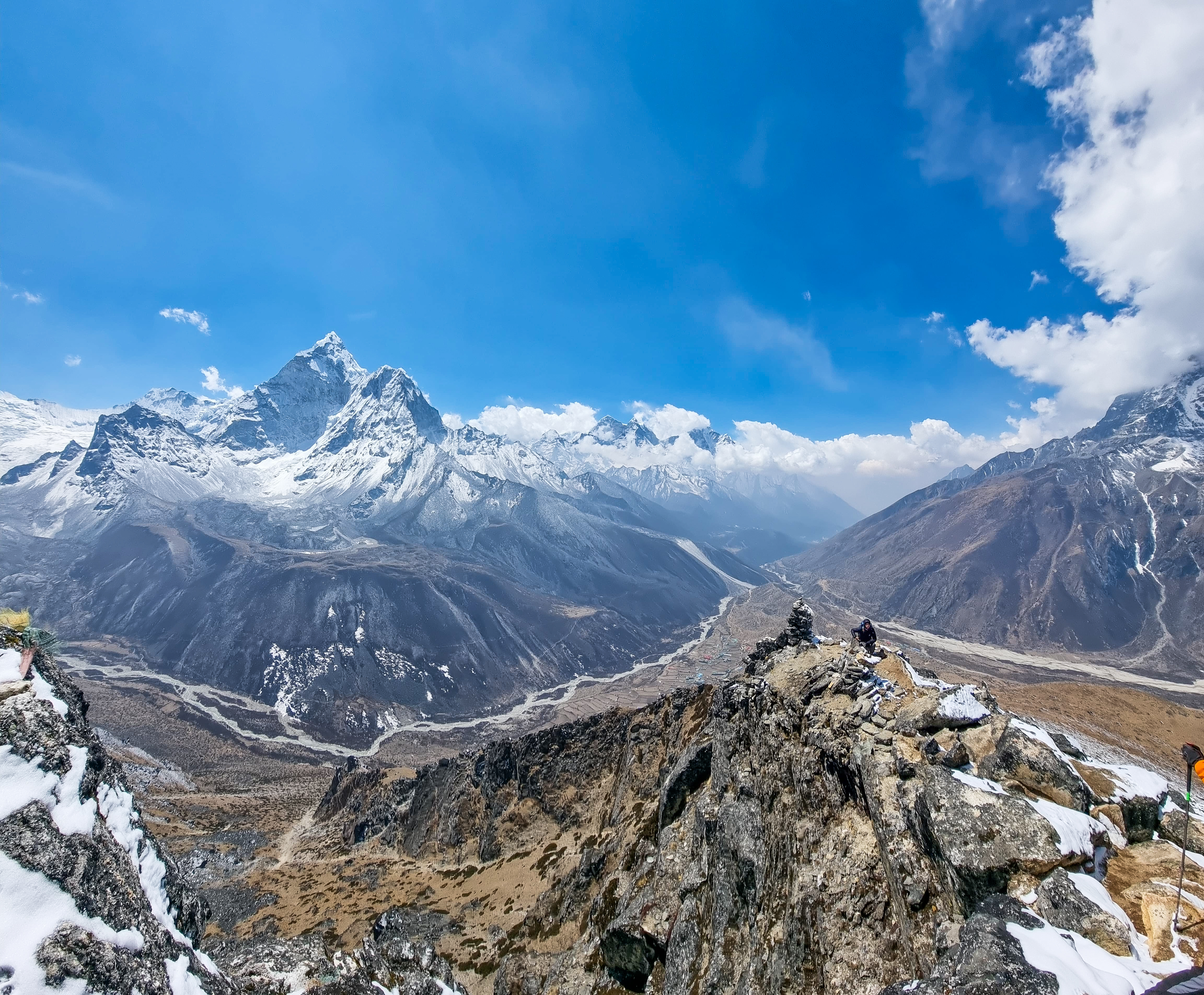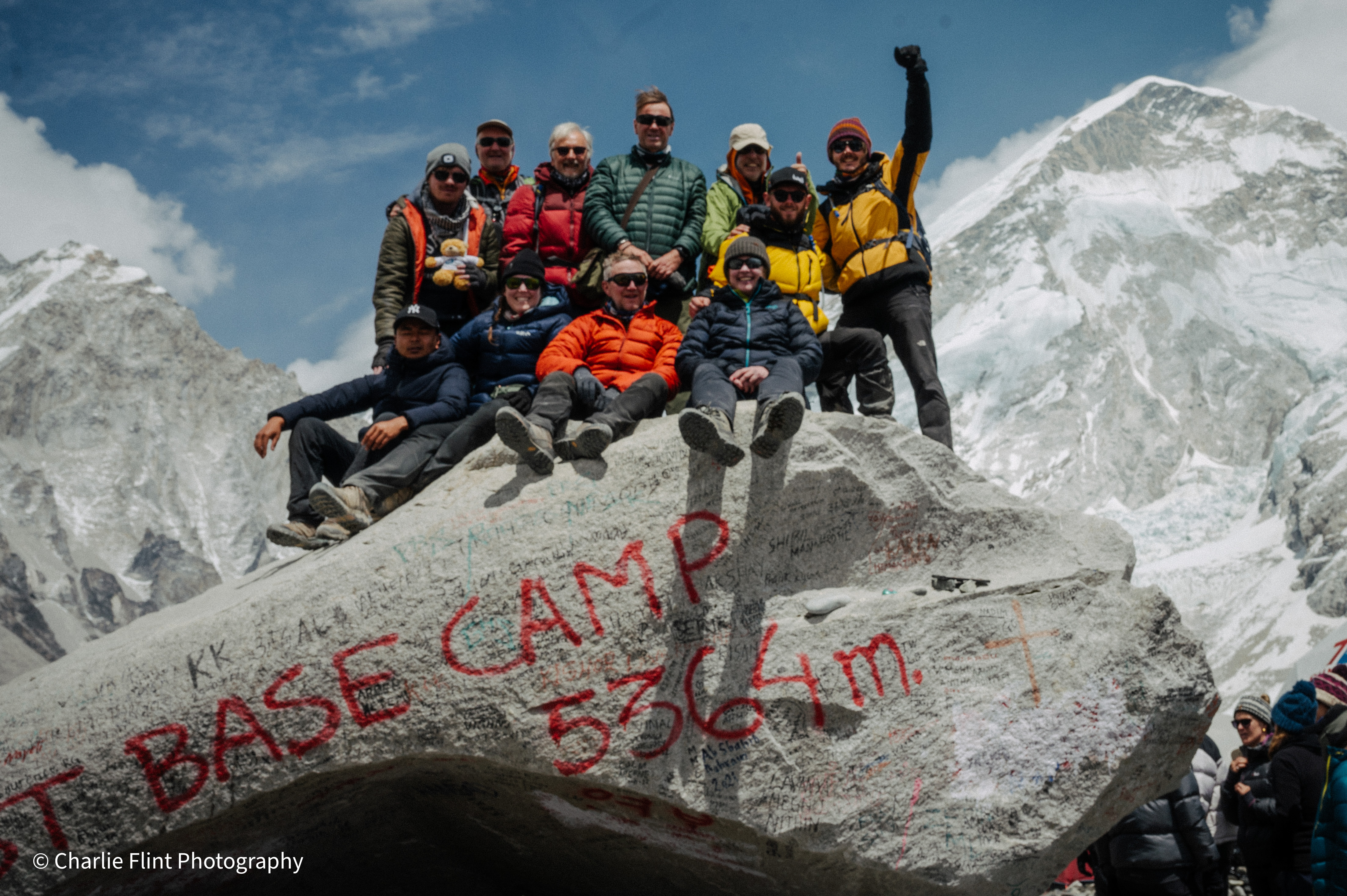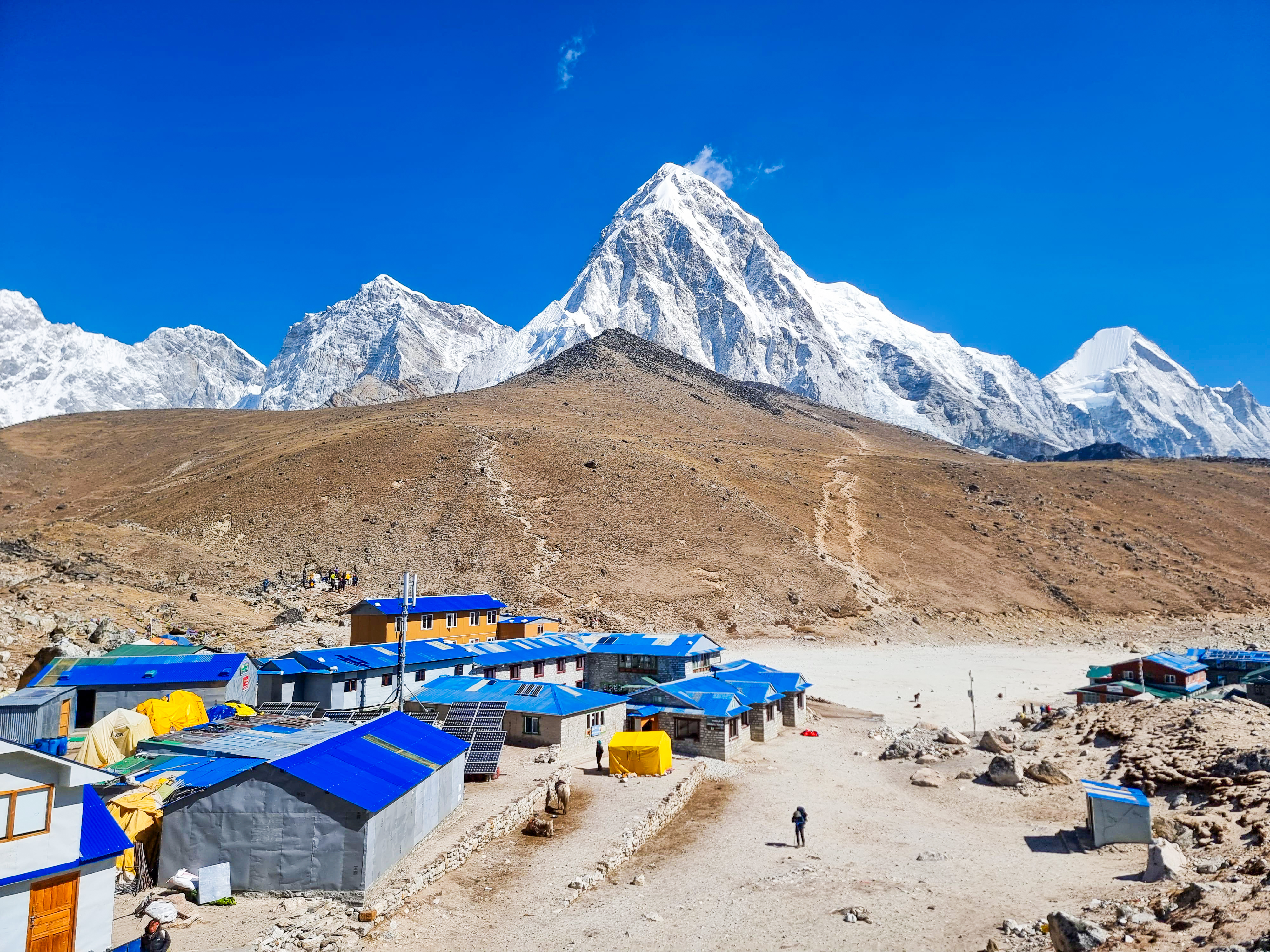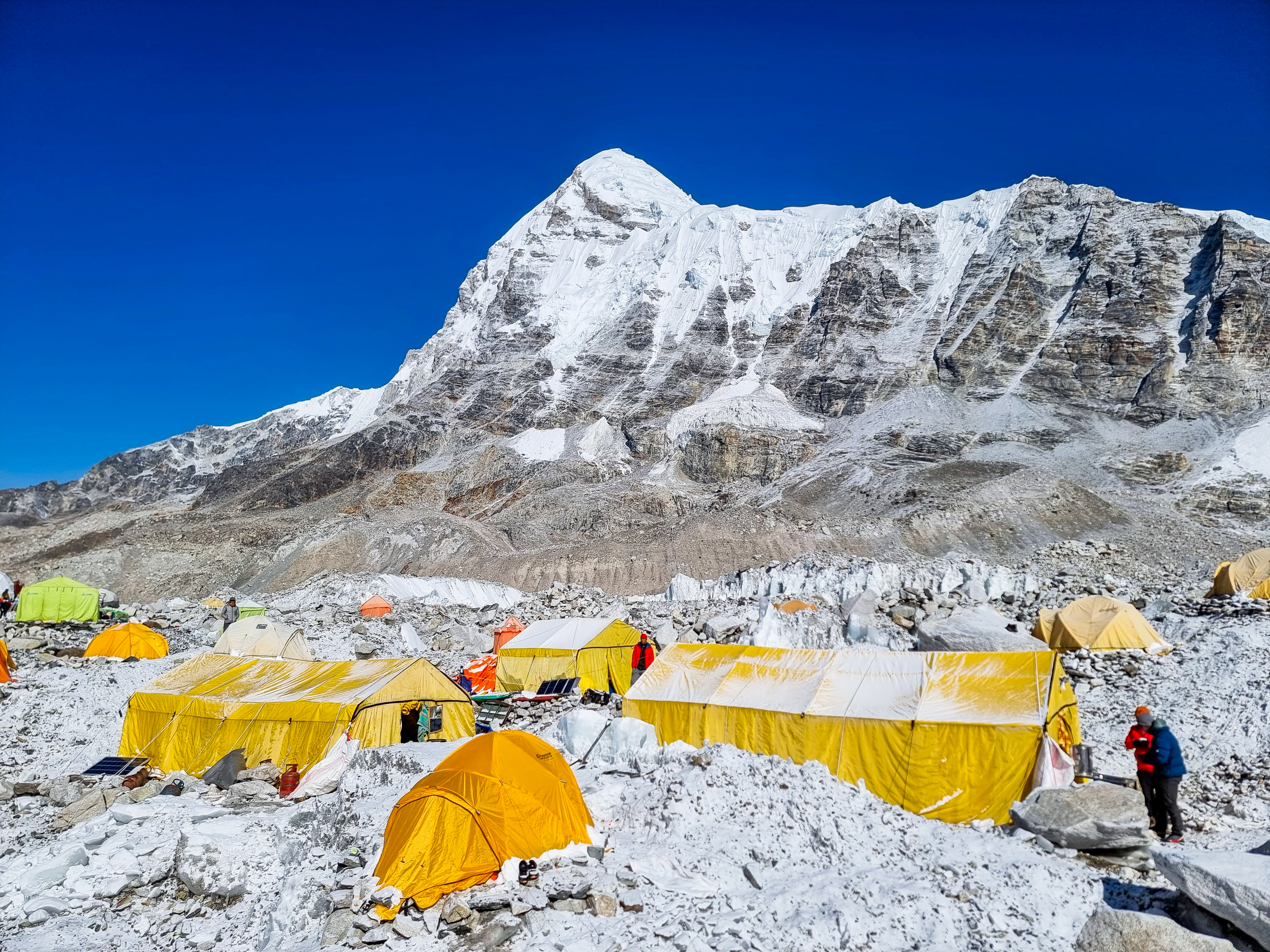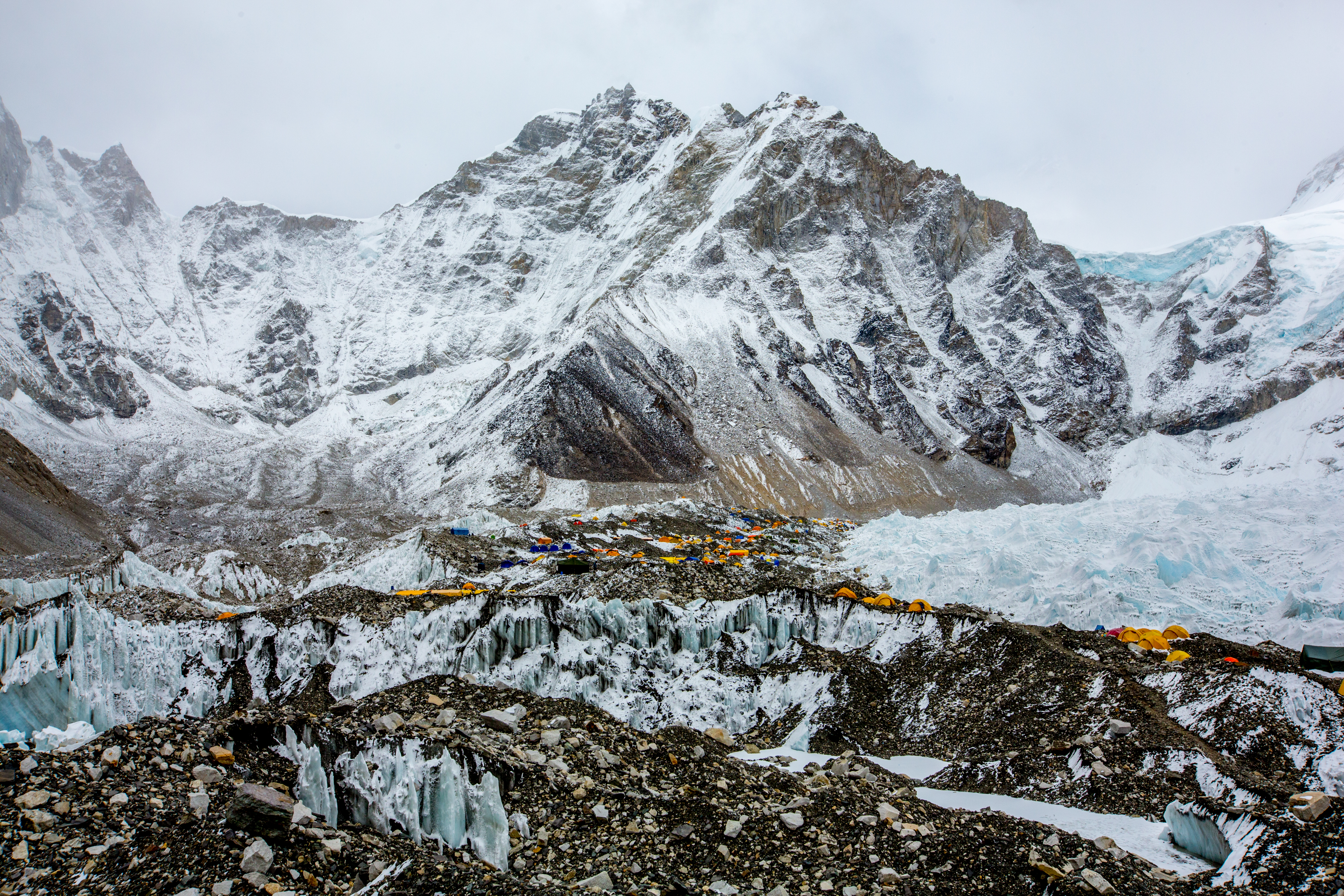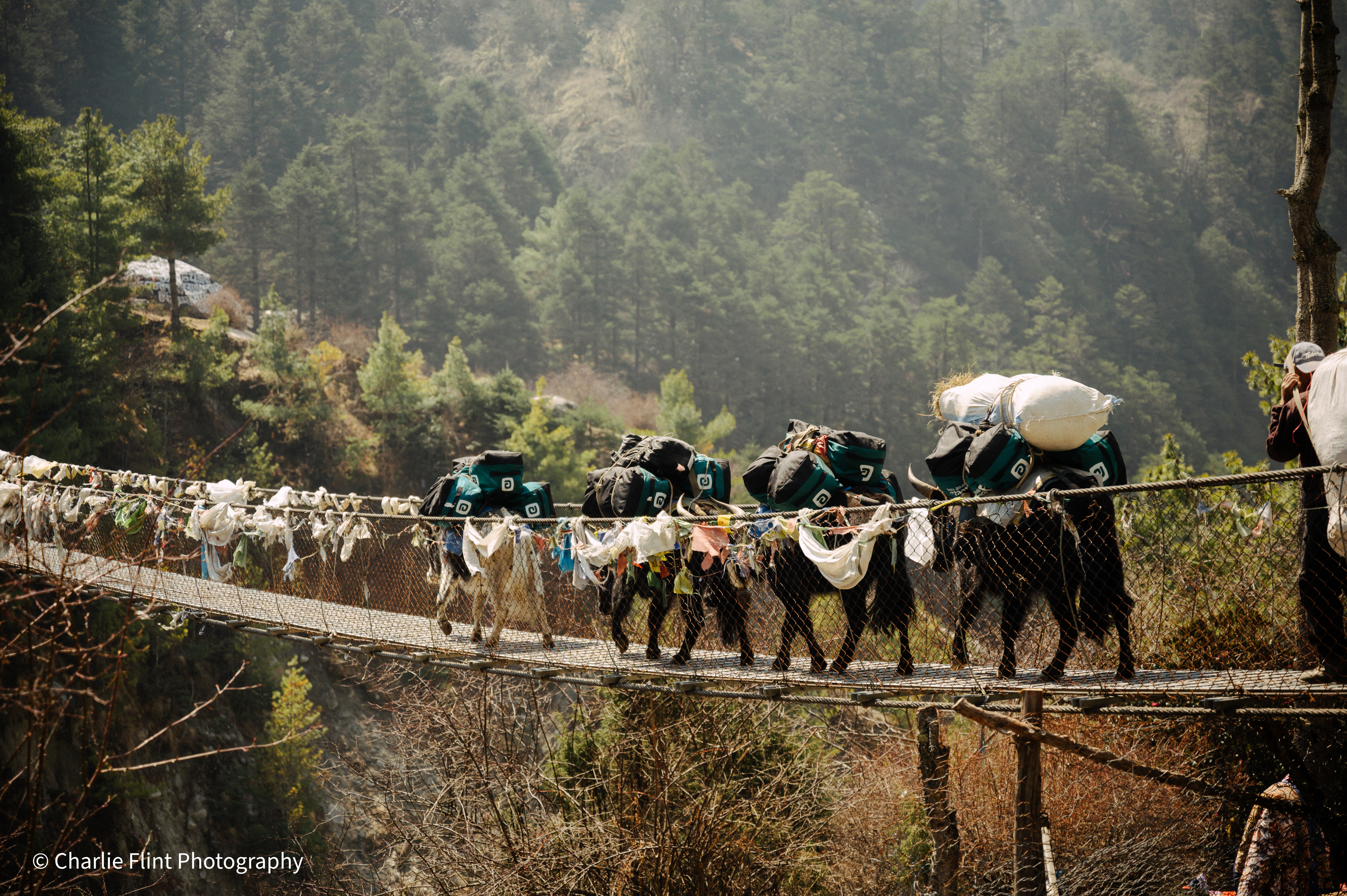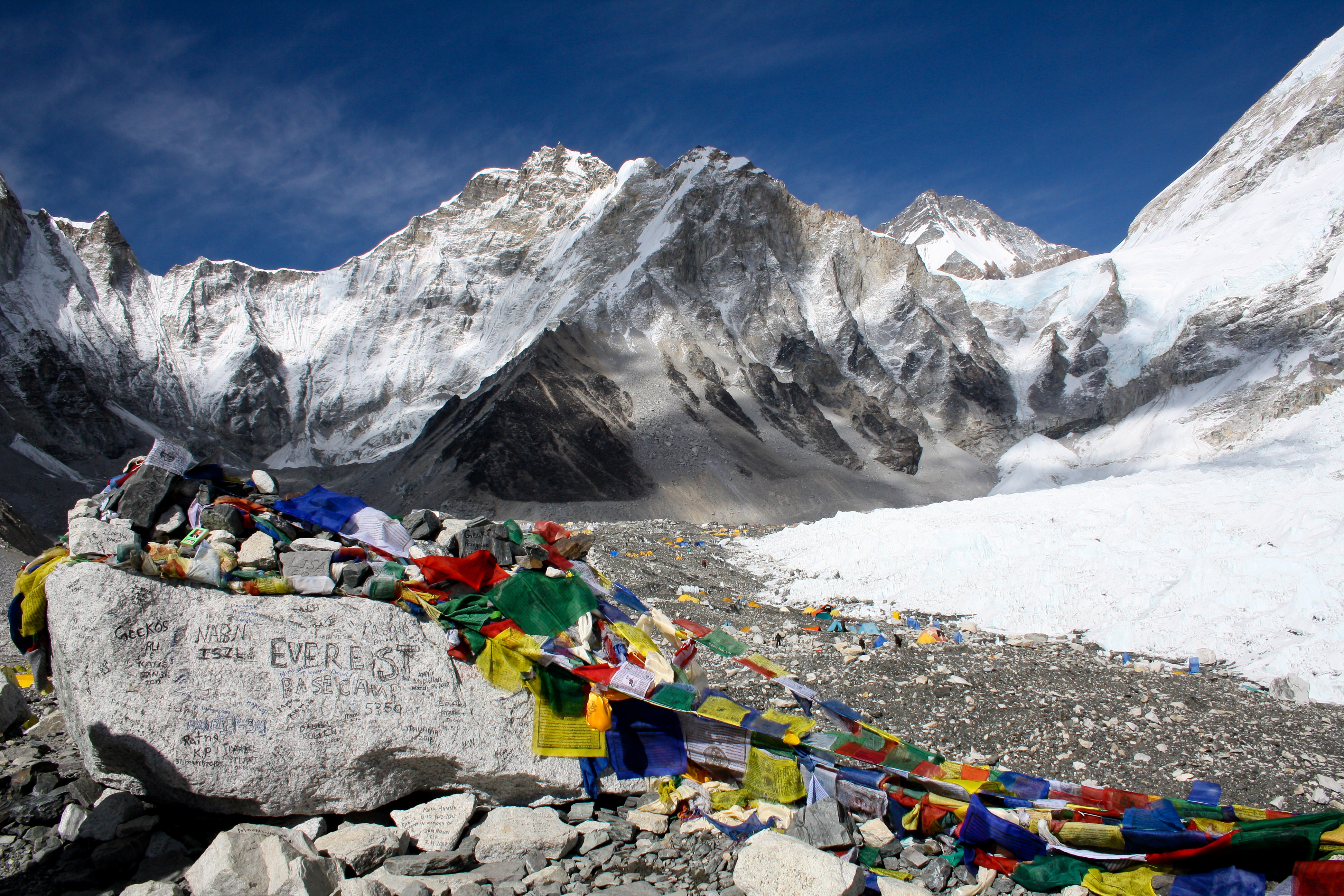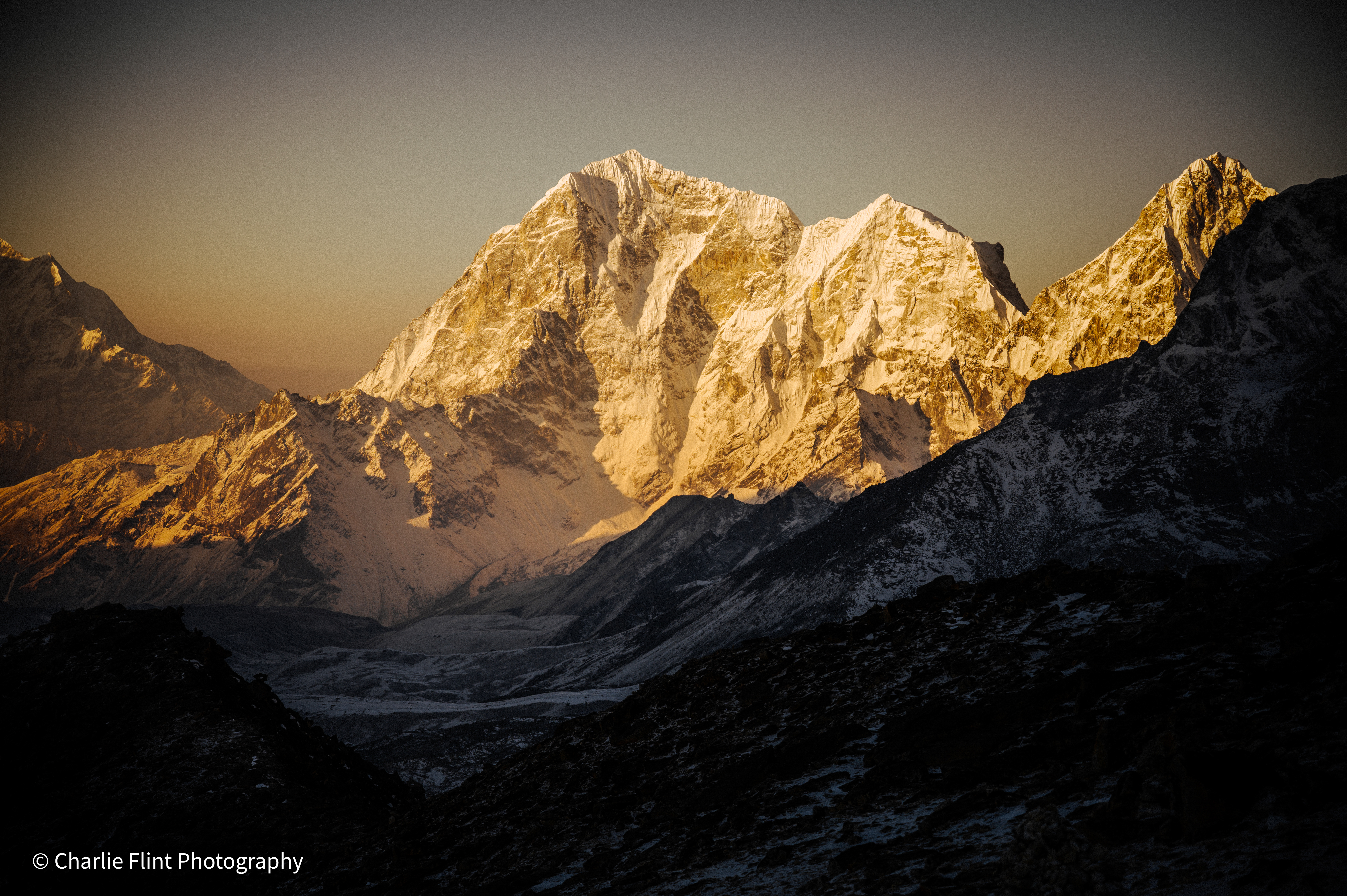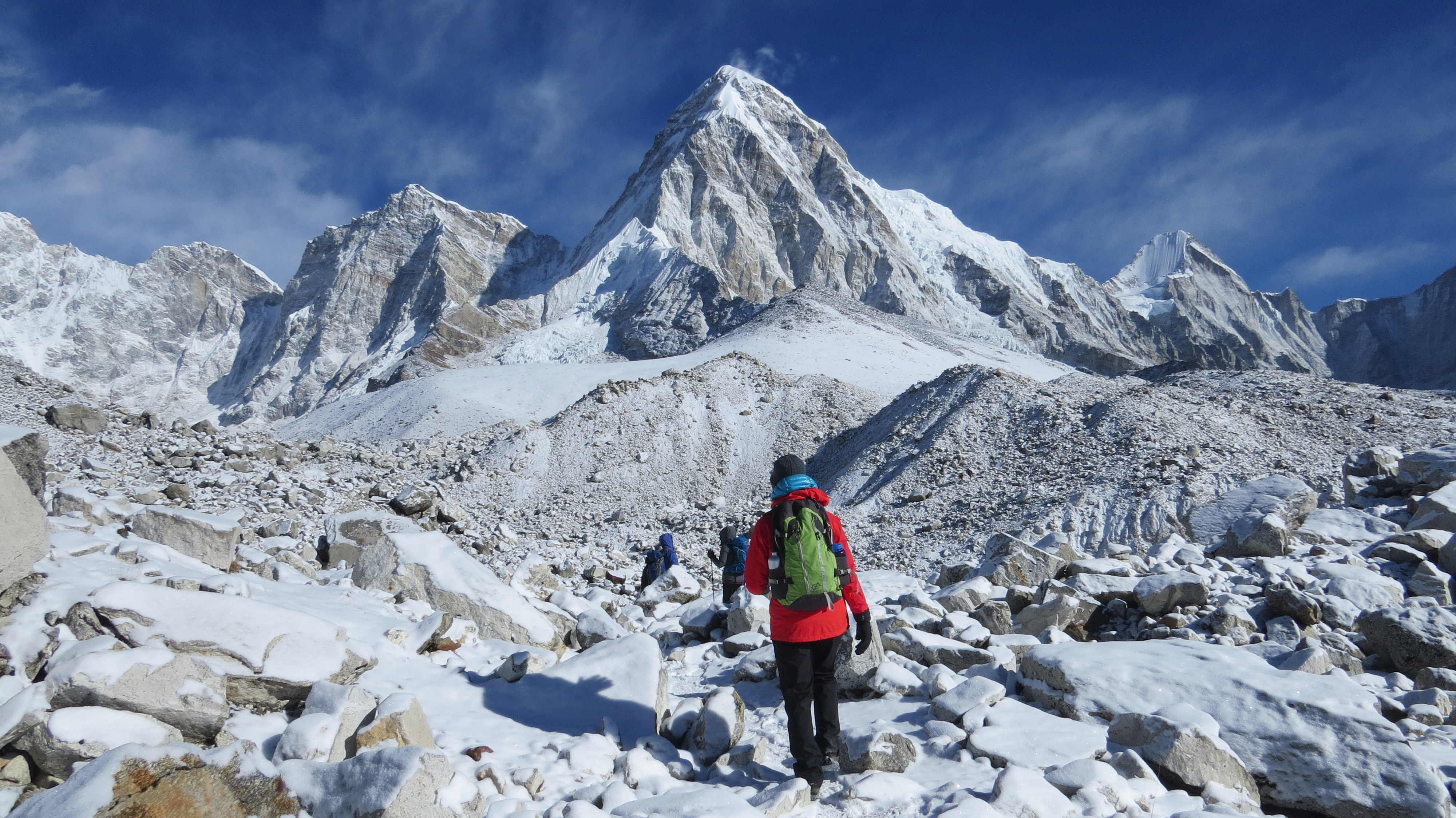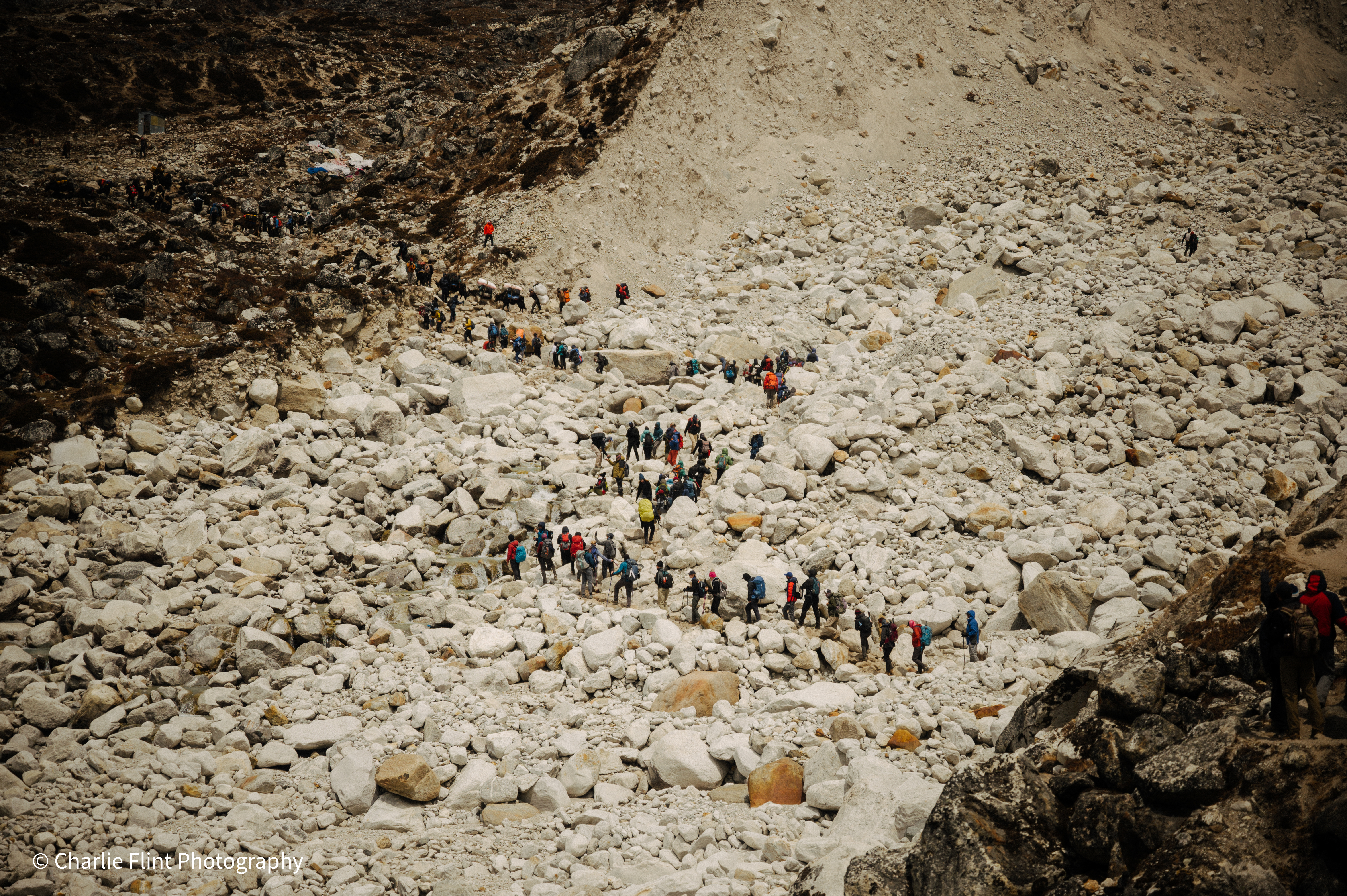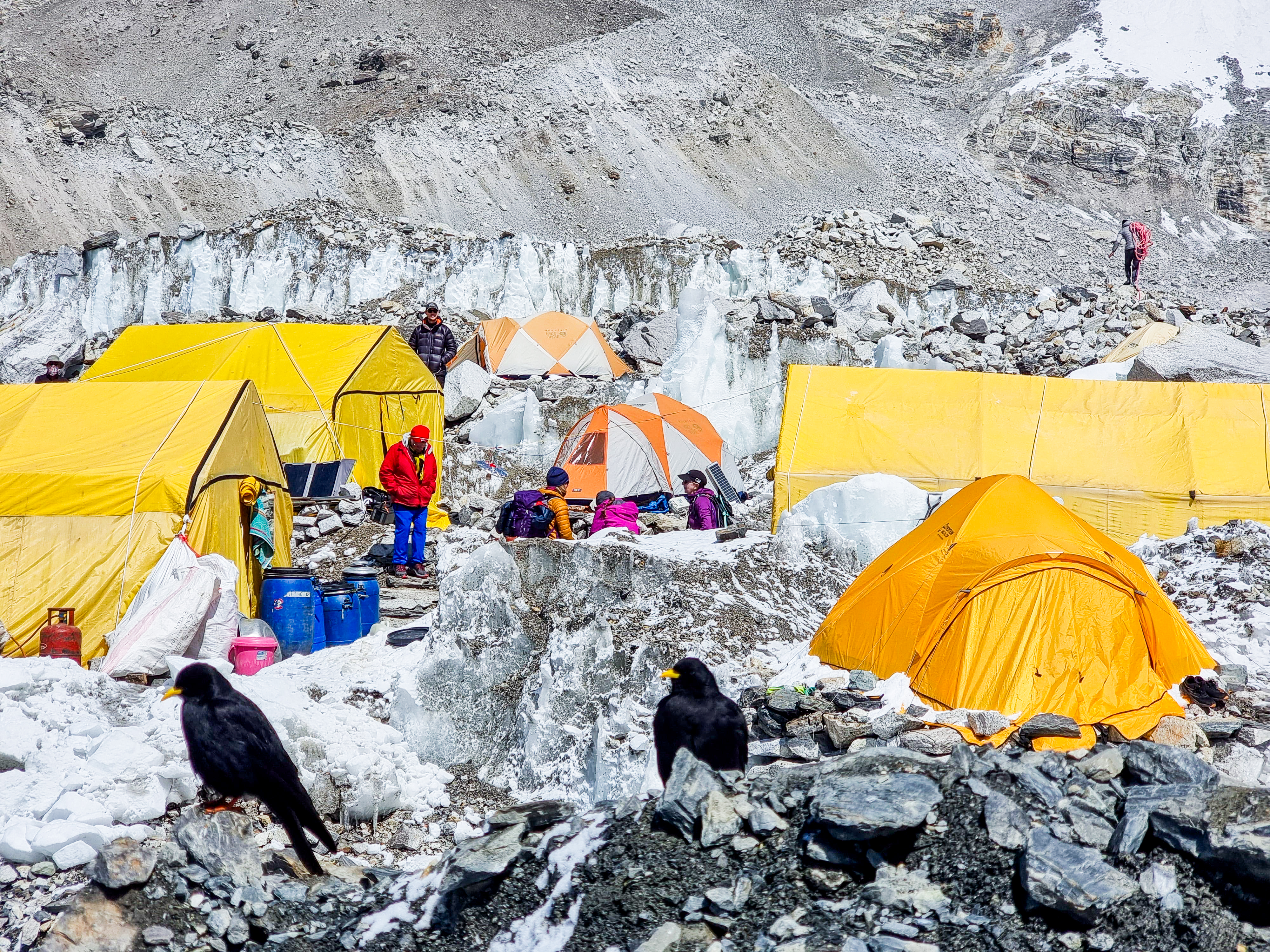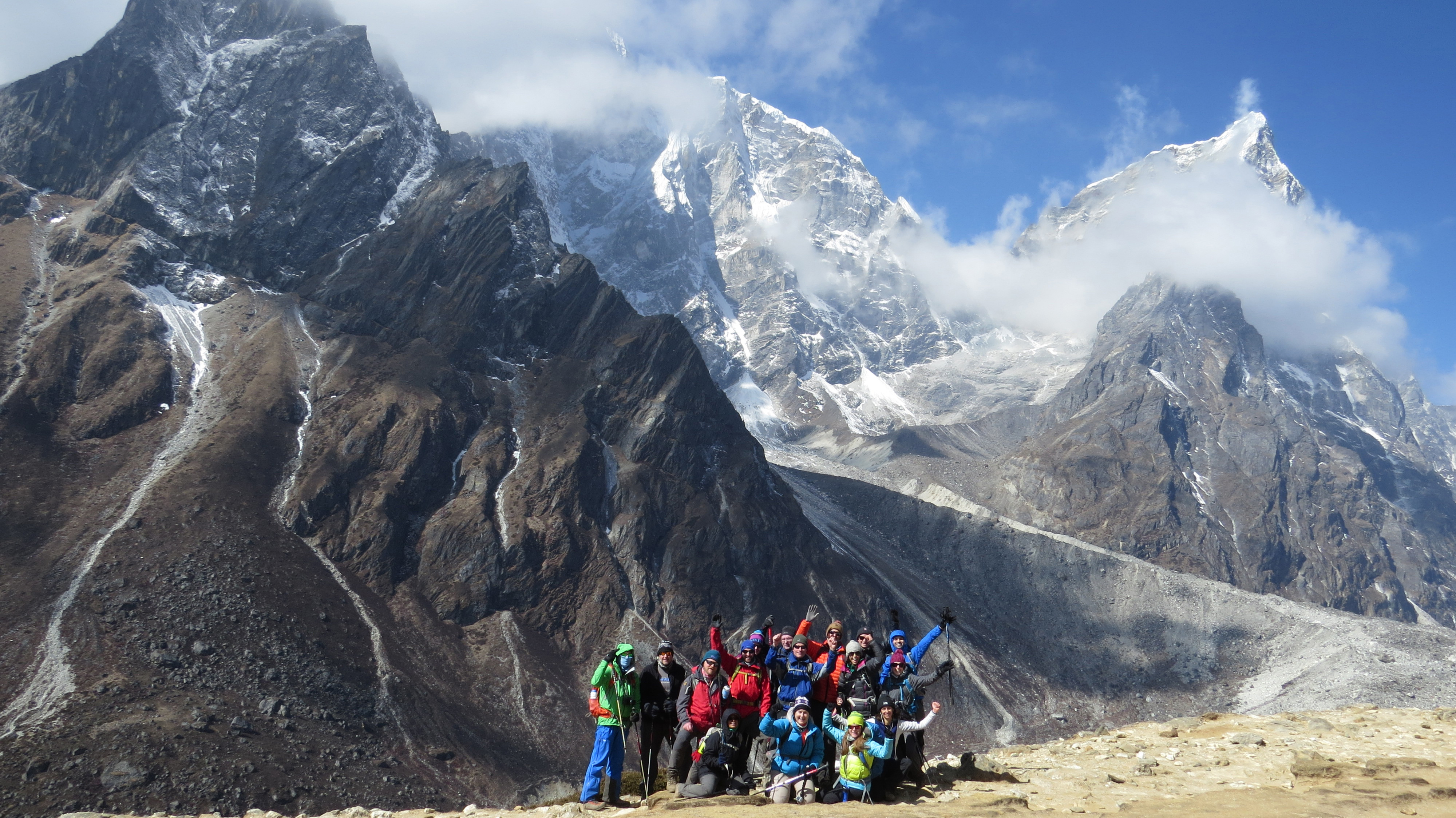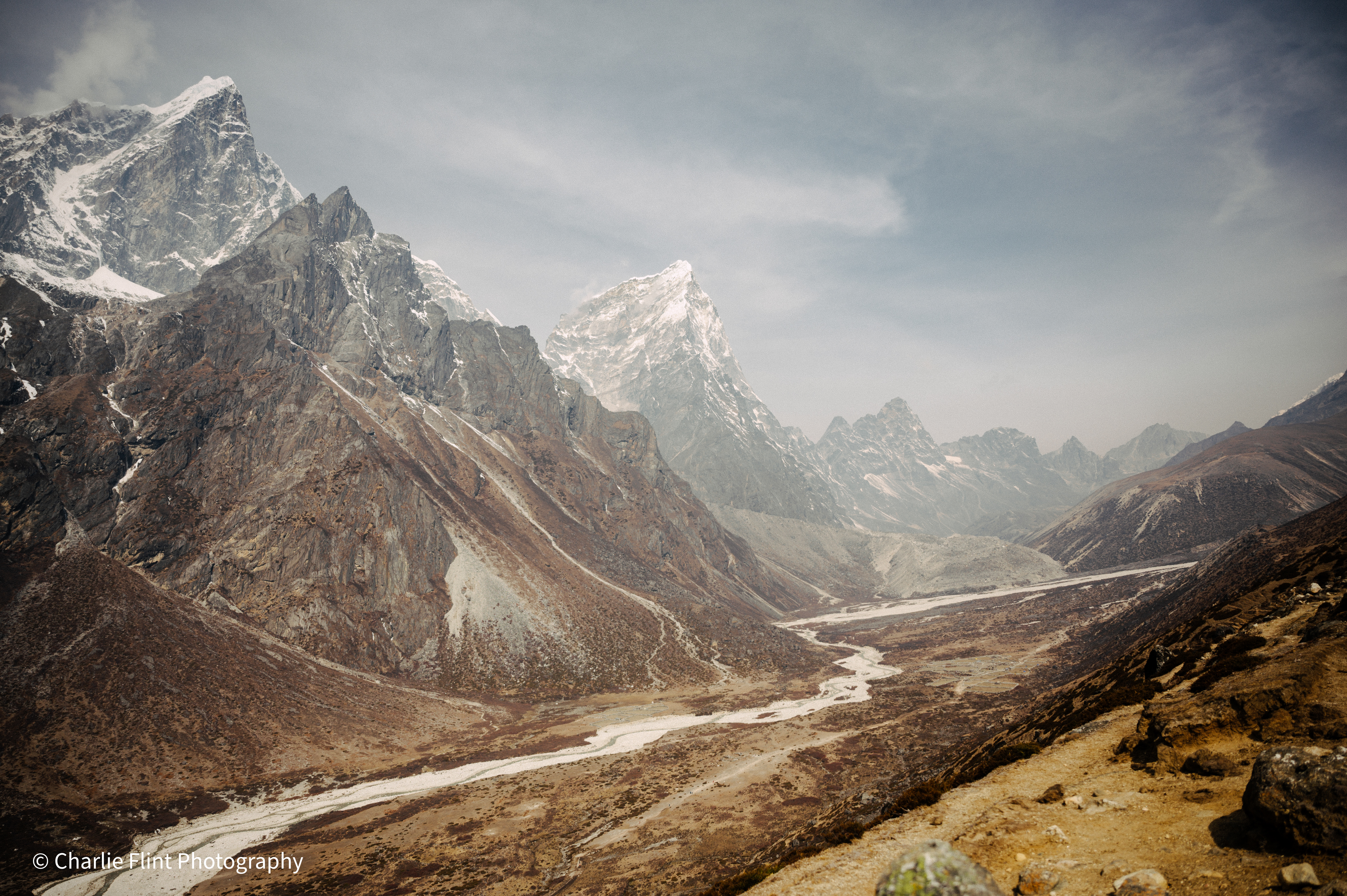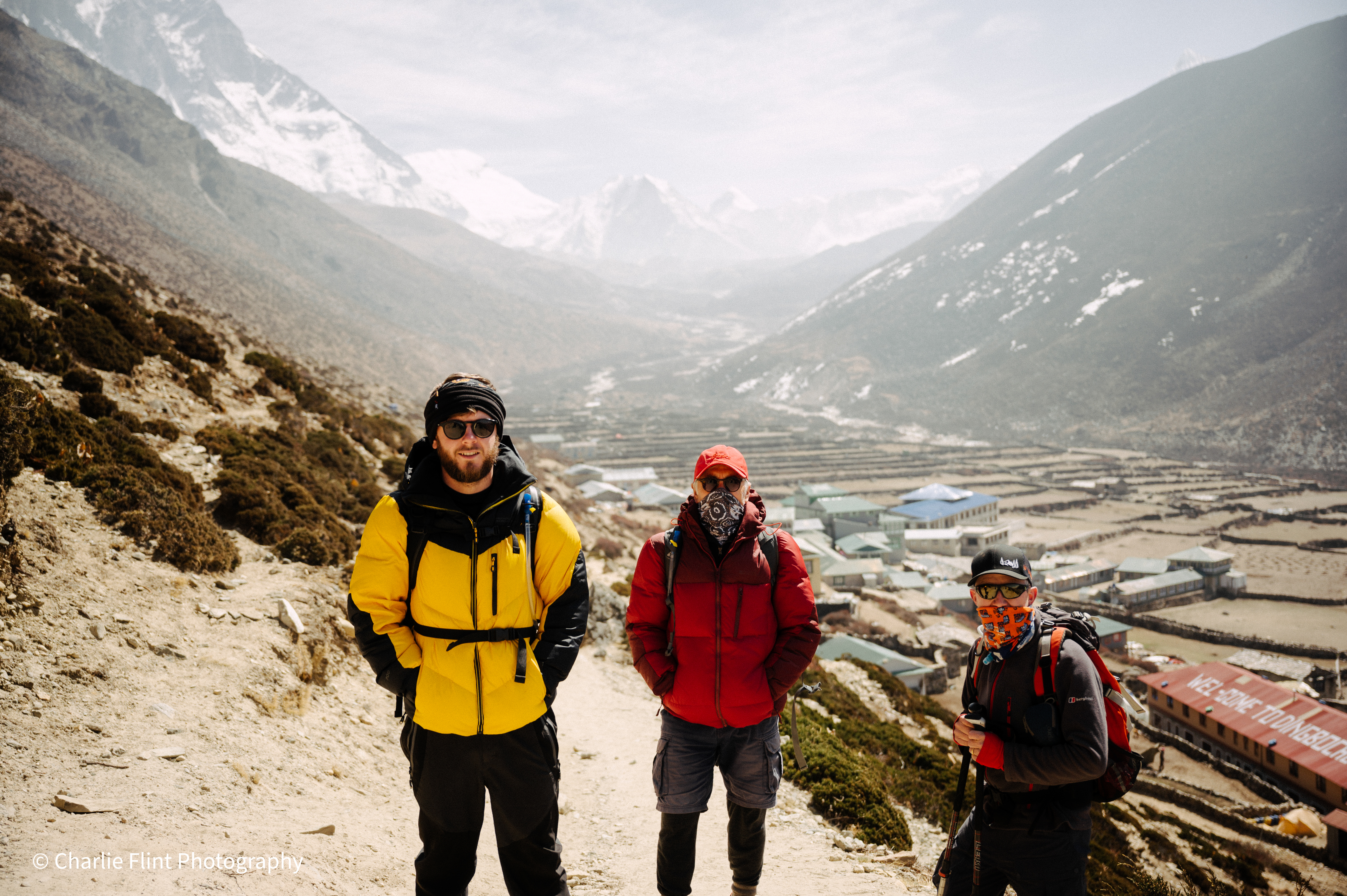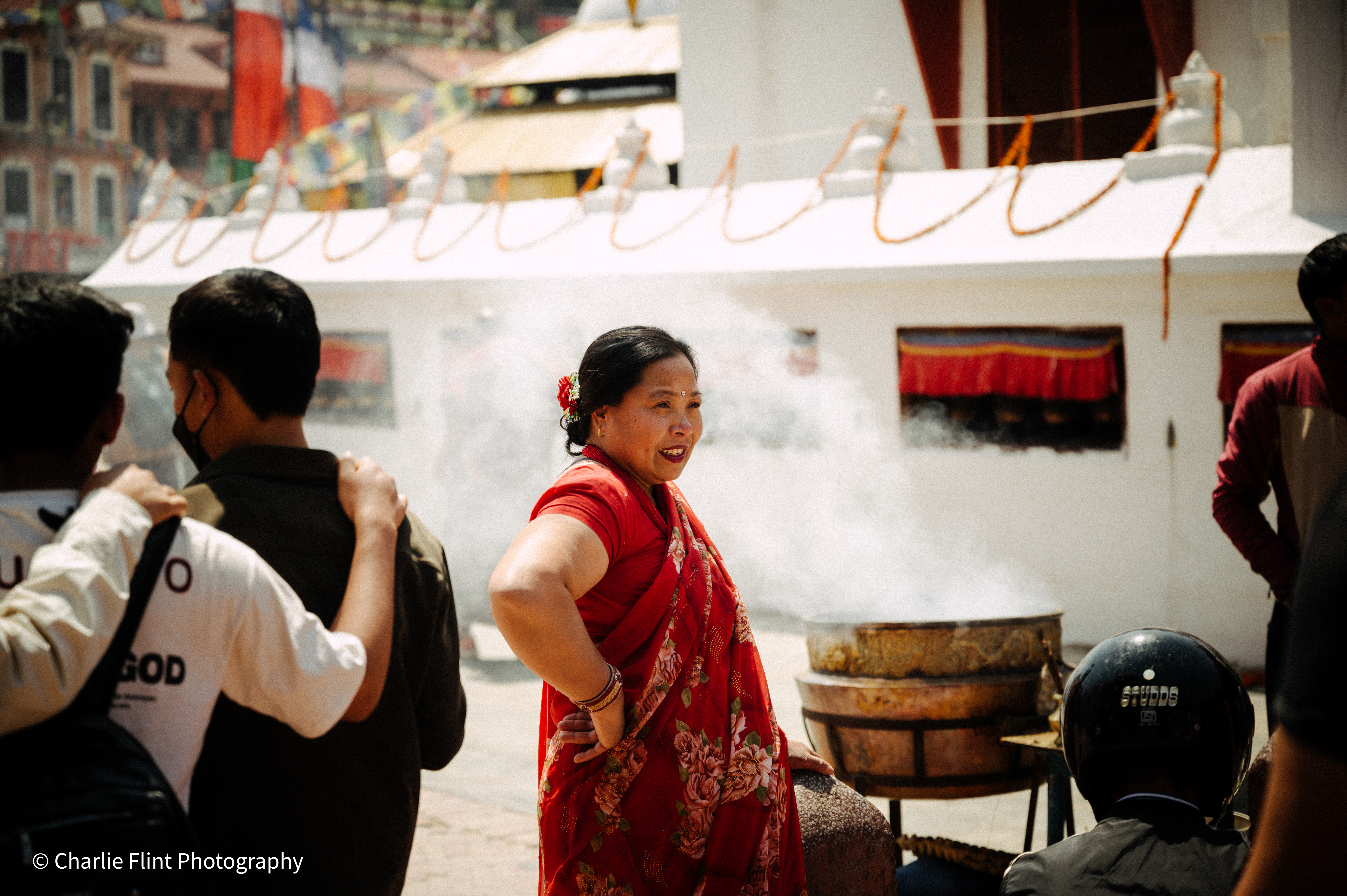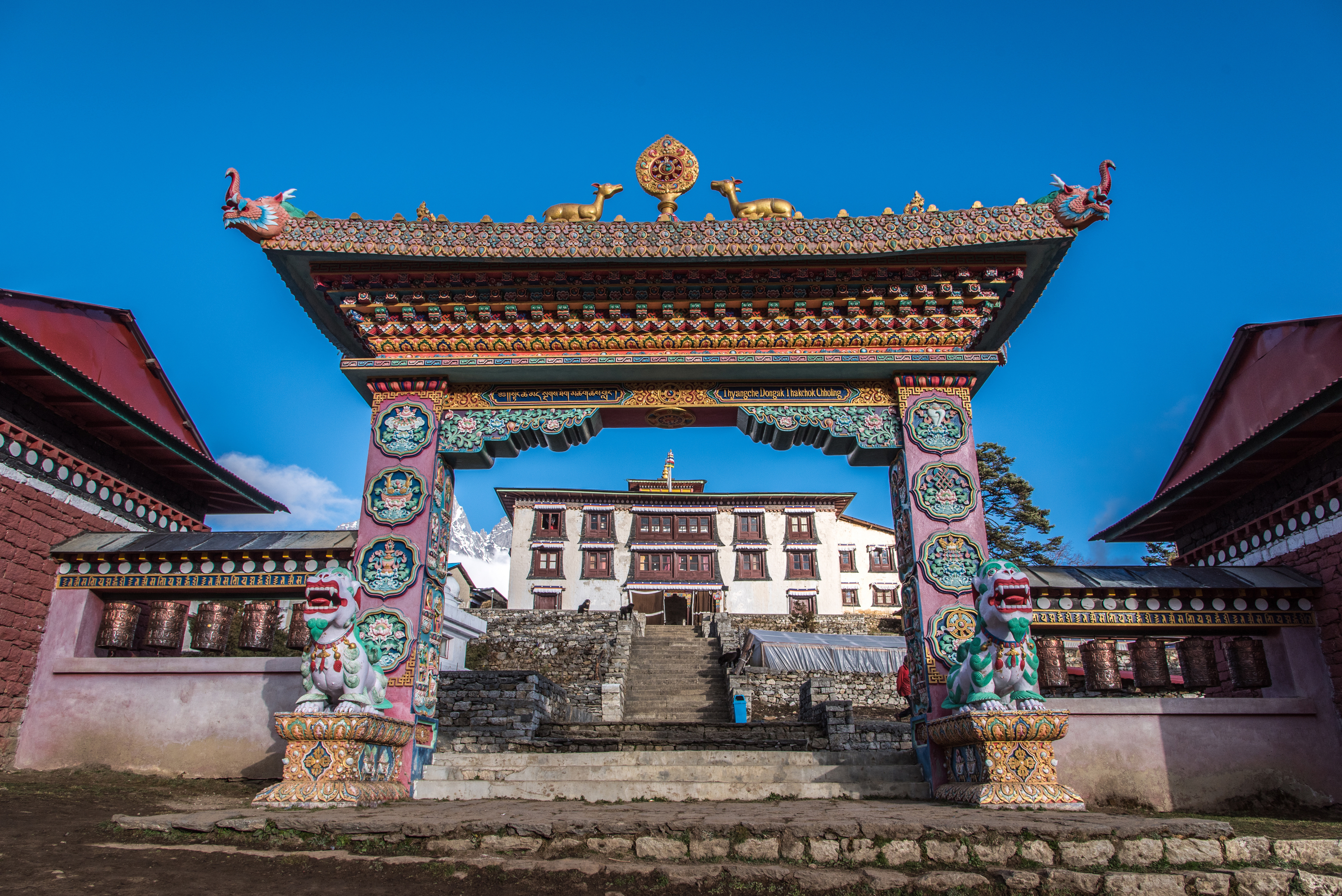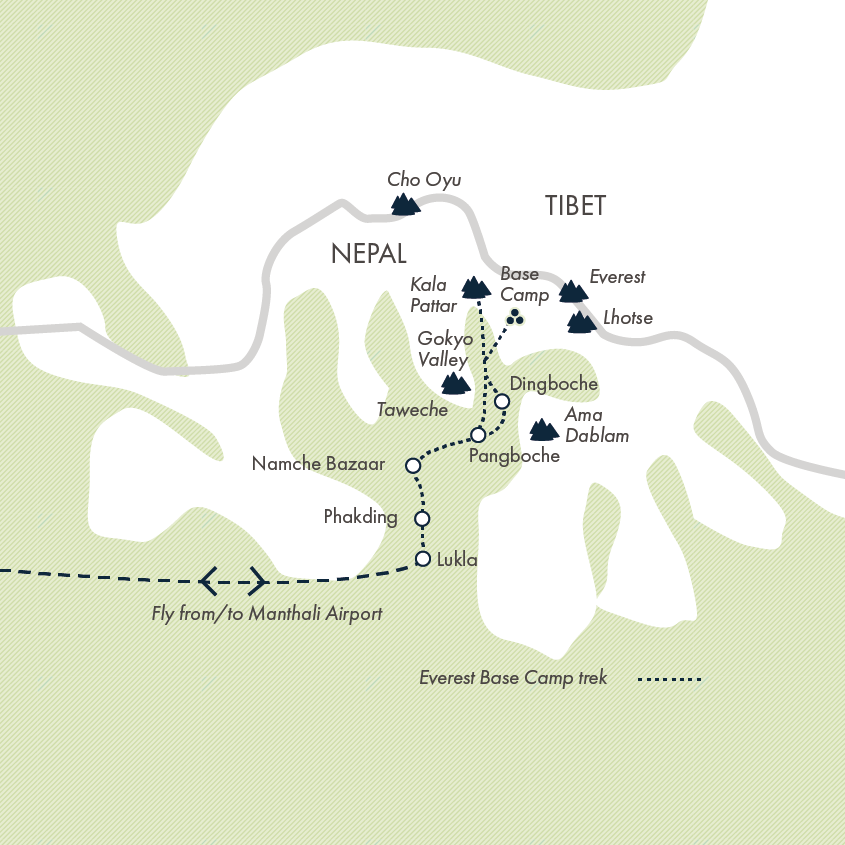Everest Base Camp Trek - Expedition Departures
Everest Base Camp Trek - Expedition Departures
$4195
Everest Base Camp Trek - Expedition Departures
18 Days Starting and ending in Kathmandu
Visiting: Kathmandu, Phakding, Namche Bazar, Kyangjuma, Tyangboche, Dingboche, Lobuche, Gorakshep, Everest Base Camp, Pheriche, Lukla
Tour operator:
Tour code:
TNTA
Guide Type:
Fully Guided
Group size:
4 - 16
Age range:
16-99
Special diets catered:
Please inform Exodus of specific dietary requirements
Tour operated in:
EnglishTrip Styles:
Active, Adventure Tours, Camping, Walking Hiking and Trekking
Interests:
Activities:
Tour Overview
Take one of the world’s classic treks: to the most iconic base camp of all, at the foot of Mount Everest (29,029ft/8,848m). This special departure has the added excitement of camping at Base Camp for one night, a magnificent setting near the Khumbu Ice Fall, at a time when it bustles with expedition parties preparing for their summit attempts. The journey to Base Camp passes through Sherpa country and allows time to acclimatise before reaching the spectacular high-altitude scenery: the incredible Thyangboche monastery, views of Ama Dablam, Everest and other mighty peaks of the Himalaya.
Valerie Parkinson, winner of the Wanderlust World Guide Awards 2021, is leading the 9 April 2026 departure.
Why trek with Exodus?
Free four-season sleeping bag and down jacket hire, available on request
One of the highest staff-to-traveller ratios on the trek with one staff member to every four travellers
More than 30 years’ experience organising treks in Nepal
Carefully planned ascent rates and itineraries with built-in acclimatisation and contingency days
We beat the Everest crowds by rising early, avoiding foot traffic on the trails and getting into the next teahouse early for hot showers
Established protocol for Lukla flight delays
Exodus annually commissions independent air-safety audits on domestic carriers in Nepal and only use those approved as part of the audit
Experienced English-speaking local leaders who are qualified in first aid and trained to recognise and deal with altitude sickness
All staff (leaders, guides and porters) are fully insured and paid a fair wage
Staff carry oxygen, a first-aid kit, and self-assessment acute mountain sickness cards, used to monitor every traveller at altitude
Speak to Exodus office staff who have done the trek themselves
Highlights
Itinerary
Day 1 : Arrive in Kathmandu
Location: Kathmandu
Accommodation: Hotel
Accommodation Name: Royal Singi Hotel (or similar)
The tour starts at the Royal Singi Hotel, which has hosted countless numbers of our trekkers over the years. There is a full trek briefing this evening, in which we gather as a group for the first time and go over any questions you may have. Rest up, we begin our trek to Everest Base Camp tomorrow.
Accommodation: Royal Singi Hotel (or similar)
Day 2 : Early morning transfer to Manthali for your flight to Lukla. Trek to Phakding
Location: Phakding
Accommodation: Hotel
Accommodation Name: Teahouse (altitude
Meals Included: Breakfast
We have a very early start this morning to drive (approximately four hours) to Manthali Airport (RHP) where all Lukla flights now operate from. We leave our hotel at approximately 3am to ensure we arrive in Manthali in time for the first morning flights to Lukla. The hotel provides a packed breakfast for the journey.
We then fly to the mountain airstrip of Lukla (9,190ft/2,800m), and set off on the first short leg of our trek, heading north up the valley of the Dudh Kosi (Milk River). We descend from the small plateau into the forested valley. The trail offers tantalising views of green, hilly terrain before reaching the settlement of Phakding, where we spend our first night.
Accommodation: Teahouse (altitude: 8,701ft/2,652m)
Day 3 : Follow the Dudh Kosi and ascend to Namche Bazaar, with time to explore Sherpa villages
Location: Namche Bazar
Accommodation: Hotel
Accommodation Name: Teahouse (altitude
Meals Included: Breakfast
Heading out of Phakding, we follow the Dudh Kosi north. Today’s walk takes us through magnificent forests with glimpses of the mountains ahead. We cross the river several times by bridge as we pass through the villages of Benkar, Monzo and Jorsale. A final bridge brings us to the foot of the steep climb to Namche. Halfway up the ascent, we may get our first glimpse (cloud permitting) of the Everest summit behind the great ridge of Nuptse-Lhotse. A last 985ft (300m) climb brings us to Namche Bazaar, the Sherpa capital and the main town in the area, which get can explore properly on our return from Base Camp. Namche is a prosperous Sherpa town and an important trading centre. It has a weekly market on Friday afternoons and Saturday mornings, but the town always bustles with trekkers, coffee shops, bakeries and stores selling all kinds of trekking and climbing gear and Tibetan souvenirs.
Accommodation: Teahouse (altitude: 11,285ft/3,440m)
Day 4 : Acclimatisation walk to Kunde and Khumjung; descend to Kyanjuma
Location: Kyangjuma
Accommodation: Hotel
Accommodation Name: Teahouse (altitude
Meals Included: Breakfast
We climb steeply out of Namche past the airstrip at Shyangboche to the Everest View Hotel, the highpoint of our day at 12,730ft (3,880m). Built by the Japanese, this spectacularly situated hotel with wonderful views of Everest and Ama Dablam is an ideal place for a tea break.
En route to the Everest View Hotel, you have the option to stop at the Sagarmatha Next experience centre and learn about the work this local organisation is doing to tackle waste pollution on the mountain trails and how you can help.
Descending through forest, we come to Khumjung, where we have lunch close to the Sir Edmund Hillary School. After, we walk up to Kunde and visit the Edmund Hillary Hospital. The twin villages of Kunde and Khumjung are below Khumbila, the rocky peak sacred to all Sherpas. For much of the walk, we have great views of Ama Dablam and other Himalaya giants. We walk back down through Khumjumg to the monastery. Sadly, it was damaged in the earthquake but is now being repaired. Inside is a small box and, after paying the entry fee (which goes towards the repairs), we are shown the only yeti skull in the world. Descending to the main trail, we spend the night at Kyanjuma.
Accommodation: Teahouse (altitude: 11,810ft/3,600m)
Day 5 : Trek through the Sherpa heartland to the monastery at Thyangboche for superb mountain views
Location: Tyangboche
Accommodation: Hotel
Accommodation Name: Teahouse (altitude
Meals Included: Breakfast
This morning, we descend to the river. We cross at the little settlement of Phunki Thangkha (10,665ft/3,250m), then climb steeply through the forest to Thyangboche (12,867ft/3,867m). We arrive by lunchtime and visit the famous monastery in the afternoon. The sunset and sunrise over the mountains is not to be missed – Everest, Nuptse, Lhotse and Ama Dablam provide a wonderful backdrop to our teahouse. Look out for Himalayan tahr, a native wild goat, in the forest surrounding the monastery.
Accommodation: Teahouse (altitude: 12,700ft/3,870m)
Day 6 : Continue up the Khumbu Valley and then the Imja Valley to Dingboche
Location: Dingboche
Accommodation: Hotel
Accommodation Name: Teahouse (altitude
Meals Included: Breakfast
We descend through the forest to Devoche and, a little further on, cross the rushing Imja Khola, whose valley we now follow. Climbing steadily, the trail enters Pangboche (12,795ft/3,900m), the highest permanent settlement in this valley. Ascending, we have lunch at Shomore, after which we leave the trees and cross a wooden bridge at the confluence of the Khumbu and Imja rivers. A short, steep climb brings us to Dingboche (14,270ft/4,350m), a summer settlement where great peaks surround us.
Accommodation: Teahouse (altitude: 14,270ft/4,350m)
Day 7 : Spend the day at Dingboche for acclimatisation
Location: Dingboche
Accommodation: Hotel
Accommodation Name: Teahouse
Meals Included: Breakfast
We spend the day at Dingboche to continue our acclimatisation. Those adapting well to the altitude can climb Nangkartshang Peak (16,730ft/5,100m) for great views of Makalu, Lhotse, Chalotse, Tawoche and Ama Dablam. There is the option to climb halfway up or, if you’re feeling energetic, it takes about 3hr 30min to the top. It’s a tough, steep climb but well worth the effort for the amazing views. We return to Dingboche for a late lunch. The rest of the afternoon is free to relax and acclimatise.
Accommodation: Teahouse
Day 8 : Continue the ascent to Lobuje
Location: Lobuche
Accommodation: Hotel
Accommodation Name: Teahouse (altitude
Meals Included: Breakfast
The trail climbs steeply out of Dingboche, past a chorten (Buddhist shrine), and ascends the valley gradually to Dugla at the end of the terminal moraine of the Khumbu Glacier. We stop here for a tea break and snack before the steep climb to Chukpo Lari, a beautiful, poignant place with a line of memorials to climbers who have died on Everest and a beautiful panorama of the peaks on the Nepal-Tibet border. The trail then eases off as we follow the valley to Lobuje, a tiny hamlet with a few teahouses. In the late afternoon, there is the option to walk up onto the lateral moraine of the Khumbu Glacier. Sunset on Nuptse is not to be missed.
Accommodation: Teahouse (altitude: 16,175ft/4,930m)
Day 9 : Follow the Khumbu Glacier to Gorak Shep
Location: Gorakshep
Accommodation: Hotel
Accommodation Name: Teahouse (altitude
Meals Included: Breakfast
We leave early, following the Khumbu Glacier northwards to Gorak Shep (17,008ft/5,184m). The trail rolls up and down along the moraine with some short, steep sections. The trail is rocky as we are now on the lateral moraine of the Khumbu Glacier. It takes us about three hours to reach Gorak Shep, where we have a rest and something to eat.
In the afternoon, we climb steeply above Gorak Shep to the small peak of Kala Pattar (Black Rock) at 18,192ft (5,545m), from where we can look over the base camps of the various Everest expeditions. This climb affords a magnificent view of the Khumbu Glacier and, above all, a close-up view of the highest mountain in the world. We return to Gorak Shep for the night.
Please note, accommodation options are extremely limited at Gorak Shep and the teahouse is very basic, though the communal dining area is warm and the food served promptly to satisfy trekkers’ appetites. Because of the high altitude, the plumbing facilities can be affected and water freezes much of the time.
Accommodation: Teahouse (altitude: 17,008ft/5,184m)
Day 10 : Continue along the lateral moraine to Everest Base Camp. Camp overnight
Location: Gorakshep
Accommodation: Hotel
Accommodation Name: Full-service camping (sleeping altitude
Meals Included: Breakfast, Lunch, Dinner
We start by walking across the sandy flat at Gorak Shep and climb onto the lateral moraine of the Khumbu Glacier. The trail ascends the side of the glacier for a couple of hours before finally descending onto the rocky glacial moraine itself. The trail winds up and down through fascinating ice seracs to the area known as Everest Base Camp. We walk past the Base Camp Rock (17,390ft/5,300m), which is covered in prayer flags and where the normal trekking groups visit, and continue through the rocky moraine into the actual base camp – a significant moment for adventure lovers the world over!
We get to our camp by lunchtime and the afternoon is free to gaze in awe at our surroundings. From Base Camp, we get close-up views of the Khumbu Ice Fall and can appreciate just how difficult it is for climbers to negotiate through the huge ice blocks. Nuptse towers above us and Pumori rears behind.
Accommodation: Full-service camping (sleeping altitude: 17,715ft/5,400m)
Day 11 : Explore the area around Everest Base Camp. Camp overnight
Location: Everest Base Camp
Accommodation: Hotel
Accommodation Name: Full-service camping (sleeping altitude
Meals Included: Breakfast, Lunch
We spend this morning at Everest Base Camp with time to absorb the way of life on expeditions. We have a walk around Base Camp and through some of the ice seracs. Meet Sherpa guides preparing to climb and you may well be able to watch climbers as they ascend the Khumbu Ice Fall and can visit the Everest ER medical tent if it is there and if they are quiet. After an early lunch in camp, we say goodbye to the adventurers ready to climb the mighty mountain as we return to Gorak Shep for the evening.
Accommodation: Teahouse (altitude: 17,008ft/5,184m)
Day 12 : Long descent to Pheriche
Location: Pheriche
Accommodation: Hotel
Accommodation Name: Teahouse (altitude
Meals Included: Breakfast
This morning before packing up, you have another chance to get up to Kala Pattar if you didn't manage to make it on day 9. We retrace our steps down to Lobuje for lunch. After a rest, we continue through the valley to the lower altitude of Pheriche for the night. Once we reach the valley bottom, it is an easy walk along into the village of Pheriche.
Accommodation: Teahouse (altitude: 13,921ft/4,243m)
Day 13 : Retrace our steps to Kyanjuma
Location: Kyangjuma
Accommodation: Hotel
Accommodation Name: Teahouse (altitude
Meals Included: Breakfast
Descending through Pheriche, we cross a small bridge and have a short climb before descending to join the main Imja Khola valley. We follow the valley down to Pangboche through an alpine meadow landscape. We drop down to the rushing river then walk through peaceful rhododendron forests to the village of Devoche from where we climb back up to Thyangboche on the ridge for lunch. We descend off the ridge to Phunki Tenga and walk back up to Kyanjuma, where we spend the night.
Accommodation: Teahouse (altitude: 11,810ft/3,600m)
Day 14 : Descend through Namche to Monzo
Location: Namche Bazar
Accommodation: Hotel
Accommodation Name: Teahouse (altitude
Meals Included: Breakfast
The walk to Namche Bazaar takes us along a beautiful rolling trail high above the Dudh Kosi. We have time in Namche and, after lunch, descend through Namche Bazaar and pick up our outward trail again to Monzo, where we stay tonight.
Accommodation: Teahouse (altitude: 9,350ft/2,850m)
Day 15 : Continue to Lukla
Location: Lukla
Accommodation: Hotel
Accommodation Name: Teahouse (altitude
Meals Included: Breakfast
We retrace our steps to Chaunrikhara, where we start the last climb to the airstrip at Lukla.
Accommodation: Teahouse (altitude: 9,185ft/2,800m)
Day 16 : Fly to Manthali; transfer to Kathmandu
Location: Kathmandu
Accommodation: Hotel
Accommodation Name: Royal Singi Hotel (or similar)
Meals Included: Breakfast
We fly back to Manthali airport on one of the first flights of the day (approximately 7am to 7.30am) to allow for the five to six-hour bus transfer back to Kathmandu arriving in the city for mid to late afternoon.
Accommodation: Royal Singi Hotel
Day 17 : Free day in Kathmandu to explore the city
Location: Kathmandu
Accommodation: Hotel
Accommodation Name: Royal Singi Hotel (or similar)
Meals Included: Breakfast
Today is free for sightseeing in Kathmandu (it is also a spare day to allow for any delays in the flights to/from Lukla). You may wish to visit the monkey temple at Swayambunath, one of the largest Buddhist stupas in the world at Bodnath, or the most important Hindu temple in the valley at Pashupatinath. We offer a full range of sightseeing tours, which can be booked and paid for locally. Please see the Optional Excursions section within the Trip Notes or the Exodus noticeboard in the hotel in Kathmandu.
Accommodation: Royal Singi Hotel
Day 18 : End Kathmandu
Location: Kathmandu
Meals Included: Breakfast
The tour comes to an end after breakfast, so it’s time to start your return journey home. If you’d like a little more time to explore Kathmandu, speak to your sales representative about extending your stay.
What's Included
-
All breakfasts, two lunches and two dinners
-
Morning bed-tea on trek
-
Welcome drink at each overnight lodge
What's Not Included
-
Travel insurance
-
Single accommodation (available on request, Kathmandu only)
-
Visas and vaccinations
Food
In the teahouses, breakfast will be a choice of bread (a slice of toast, chapatti or Tibetan bread), egg (boiled, fried or omelette), and either muesli or porridge each day. Hot tea/coffee is also served. On some days, there will not be a choice for breakfast and either a trekkers breakfast (egg, hash brown, baked beans and toast) or a pancake with jam/honey will be served. You may also be able to supplement your included breakfast with additional items on the teahouse menu should you wish – additional items not included in the set menu should be ordered and paid for separately.
Please note, some more remote teahouses/lodges are unable to provide an extensive menu due to irregular delivery schedules. During periods of bad weather or a high volume of trekkers, there may be a more limited menu choice. Also, the menus and extras are generally more expensive at higher altitudes.
Lunches are taken at a teahouse en route – sometimes one of your guides will go ahead with the group’s order to make it more expedient. Dinner is in the same teahouse you sleep at (this is custom in Nepal as teahouses base their room rate on it).
Although most lodges have almost identical menus, they are reasonably extensive and offer a varied selection, ranging from traditional Nepalese dhal bhat to pizza and apple pie. Dhal bhat is the staple diet in Nepal and comes in many different forms but generally comprises curried lentils and meat or vegetables, some rice, and a pickle/chutney. Another popular snack is momos: a Nepalese dumpling (fried or steamed) that’s filled with meat or vegetables.
Meat is available in the teahouses but we advise against eating it. Meat is often carried in the heat for several days before reaching the lodges and can cause stomach upsets or illness. Germs can also be spread by handling dirty money – we recommend using hand sanitiser.
Dietary requirements
Gluten-free diets: We strongly recommend you bring extra food and snacks with you to supplement the food on trek as there will be little variety available to you, particularly for breakfast. Even many of the soups are powdered and contain gluten. Gluten-free breakfast options are limited to vegetable fried rice and a choice of egg. On specific days only, a trekkers breakfast (without the toast/with an extra egg) will be served.
Vegan diets: Breakfasts are limited to a choice of muesli/porridge made with water each day, and on specific days only, a trekkers breakfast (without the egg) or vegetable fried rice.
Lactose-free diet: The same will apply although you will also have a choice of egg each day.
If you buy imported food and drink on trek, you will spend more than the suggested amount.
Drinking water
Staying hydrated is important when undertaking any physical activity but particularly so at altitude where it is generally recommended to drink at least 0.7gal to 1gal (three to four litres) per person per day.
We strongly encourage you not to buy bottled water on trek as this contributes to the growing problem of plastic pollution in Nepal.
The teahouses sell boiled water for approximately 150-300 Nepalese rupees (US$1.15-US$2.30) per litre (the price increases the higher you trek), which should not require treating. This is also perfect for a bedtime refill as it can double as a hot-water bottle.
Alternatively, all teahouses provide free cold water. This should not be drunk untreated, so we recommend you bring a reusable bottle/water bladder/CamelBak (ideally two and wide mouth) and use an effective form of water treatment. There are a wide range of products available including Steripens or purification tablets, which are the quickest and easiest options to use on trek – we recommend talking to an outdoor retailer for the latest advice as technologies are improving all the time. Make sure to check the product’s performance in cold/freezing conditions and consider battery life (lithium batteries are best in cold conditions).
Exodus has partnered with Water-to-Go, a filtration system that eliminates more than 99.99 percent of all microbiological contaminants from any non-saltwater source – visit Water-to-Go for more information. Exodus customers can claim 15 percent off their first order and, better still, 15 percent of the purchase value will be donated to the Exodus Travels Foundation. These bottles filter the water as you drink, though the spout may not be the most efficient while moving on trek. Please note, if the water freezes it will clog up the filter. In this event, defrost before use by sitting the filter in lukewarm water for 10-15 minutes.
Accommodation
Hotel Royal Singi, Kathmandu
The Hotel Royal Singi, a three-star hotel, has been welcoming Exodus travellers for more than two decades. The name is inspired by the Snow Lion, a mythical creature in Tibetan Buddhism, which symbolises immense joy, positivity, delight and comfort. The hotel embraces the name with a restaurant, bar, outdoor courtyard, and complimentary wifi throughout. There’s also an Exodus desk in the lobby and an Exodus representative is usually available daily in the mornings and evenings. The Royal Singi is well located near the Thamel district, close to banks, restaurants, shops and attractions.
Teahouses in the Everest region
Staying in teahouses is a time-honoured tradition for expeditions to Everest Base Camp and, in fact, most hiking trips within the Himalaya. They may be basic, but teahouses become a welcome sight after a day of hiking through the region. The hub of teahouse living is the dining room, which is usually decorated with colourful, traditional rugs, sometimes with a stove or heater (some lodges charge a fee to put the heater on). Most teahouses sell snacks and other essentials such as tissues, soap and toilet paper.
We stay in twin-share bedrooms, which come with foam mattresses, bedsheets and a pillow. Remember to bring (or hire) a sleeping bag, rooms are unheated so can get cold at night.
Below are a couple of the teahouses we typically use en route.
Green Tara Hotel, Namche Bazaar
The Green Tara Hotel is one of our most popular teahouses on the Everest trail, offering cosy accommodation and warm hospitality. The comforts of a hot shower, delicious Sherpa cuisine and a snug dining space allow you to relax during your stay. The restaurant, wifi, charging ports and warm lounge enhance your experience, while the breathtaking views of Namche Bazaar and Himalaya mountains certainly leave a lasting memory.
Ama Dablam Lodge
One of our most-liked lodges in the Everest region, with an amazing view to Ama Dablam (we usually have breakfast on the terrace looking across to this beautiful mountain). You will also enjoy true Sherpa hospitality here thanks to Tashi Sherpa and her family. Tashi also runs a bakery, so make sure you try her famous fresh apple pie and homemade cookies.
Worth knowing
Some teahouses above 9,845ft (3,000m) may not be heated due to local environmental restrictions. Occasionally, kerosene burners can be used to heat common areas if requested. We recommend against using these due to the risk of carbon monoxide poisoning. Your leader will not offer this to you.
Almost all teahouses have electricity, but it is not wholly reliable and lighting may not be bright enough to read by – a torch (flashlight) is essential. Charging facilities are generally only available in the dining room (charged at approximately 200-500 Nepalese rupees/US$1.50-US$3.80 per hour per device). Many of the lodges use solar power, so sometimes there is not enough electricity for charging. Many lodges have wifi, though it can be slow and temperamental.
Most lodges have only one or two basic toilets and sometimes these are outside the main building. Toilets are usually squat-style, although many lodges have now installed seated ones. Toilet paper is not provided, so you should bring your own or buy it locally (please dispose of it in the bin provided). If there is not a flush handle, there should be a container of water to pour down – if it is empty (or frozen), please refill it or ask the lodge to.
Some lodges have hot ‘showers’ (charged at approximately 250-500 rupees/US$1.90-US$3.80 per shower). Sometimes this is simply a bucket of hot water.
Standards of cleanliness vary, especially in the peak trekking season and in winter when the water freezes at night. Please report any problems to your leader or the lodge and be vigilant in your personal hygiene regime – use soap or hand sanitiser gel before and after toilet breaks, snacks and mealtimes.
Generally, the higher the altitude, the more basic the lodges and the more expensive food and services.
Extra accommodation
If you require additional accommodation in Kathmandu, either before or after the tour, we can book this for you (subject to availability). Please enquire with your sales representative.
Single accommodation
If you prefer your own room, we offer a single supplement for the hotel nights in Kathmandu only (subject to availability). While in the teahouses, single rooms cannot be guaranteed so these have not been included in the single supplement price paid in advance. However, if a single room is available on arrival to a tea-house, you can pay locally on a day-by-day basis.
Check out our Q&As
-
Are the local guides on the tour English speaking?
Yes, our local guides are English speaking.
-
Is there a supplement for solo travellers?
If you would like to be paired with a tour member of the same gender, there is no additional charge. A single supplement can be requested if you would like your own room.
-
Are flights included in this tour?
International flights are not included with this tour.
-
Who is Exodus Travels?
At Exodus Travels, we've been exploring the world for nearly 50 years. From Walking and Trekking, Cultural and Cycling, Responsible Wildlife, to Polar and our new Premium Adventures, we are proud to offer award-winning small group and self-guided tours to 100+ countries worldwide.
-
Can you assist with pre or post tour accommodation?
We are happy to assist with pre and post tour accommodation. Please enquire for detailed information.
-
Are children permitted to take part in the tour?
The minimum age for this tour is 16 years old.
-
What happens if I need to change my holiday date once I’ve booked?
If you wish to make any changes to your booking, particularly if you need to alter any flights booked through us, please let us know as soon as possible. There is a booking or flight amendment fee of £40 per change and flight amendments often incur extra airline costs depending on the changes to be made and if the ticket has been issued or not.
-
How long has the tour company been trading?
Exodus has been trading since 1974
-
What documents will I receive before I travel?
Your final joining instructions and flight details, if booked with us, will then be sent out 2 to 3 weeks before departure. If you would like a hard copy posted, or if you require these any earlier, please contact the customer operations team. We advise that if you are booking connecting travel before receiving these, please ensure you leave plenty of time.
-
Do you operate a “single share” option and how does it work?
Travellers are welcome to opt to share a room with a tour member of the same gender for no additional charge. If you'd like your own room, we can request a single supplement so that you will have your own room throughout.
-
Can I join the tour once it has departed?
You are welcome to meet the group after the tour has departed however there is no reduction in rate for joining a tour after the departure date.
Reviews from travellers on this tour
1 Select your preferred date
Thursday - Sunday
Apr 02, 2026 - Apr 19, 2026Thursday - Sunday
Apr 09, 2026 - Apr 26, 2026Book with Confidence
-
Transfer as credit for future tours
Exodus Adventure Travels allows you to transfer existing payments to a future tour to avoid cancellation fees if you can't travel and inform exodus adventure travels, 90 days before departure.
-
Low Deposit
Exodus Adventure Travels requires a minimum deposit of 25% or the full booking value, whichever is less, with the final balance not due until 120 days before departure.
-
Cancellation Policy
We don't charge a cancellation fee, here is a summary of exodus adventure travels charges.
Up to 90 days before tour starts: Forfeit 100% of deposit.
At 89 days before tour starts: Forfeit 50% of booking price.
At 51 days before tour starts: Forfeit 75% of booking price.
At 30 days before tour starts: Forfeit 100% of booking price.
